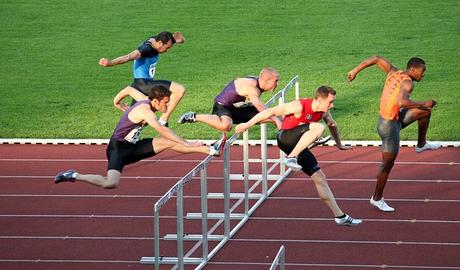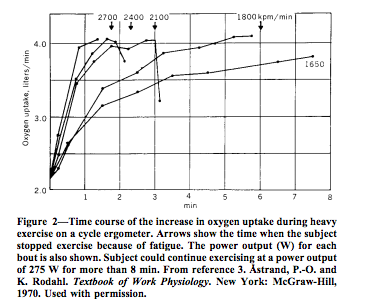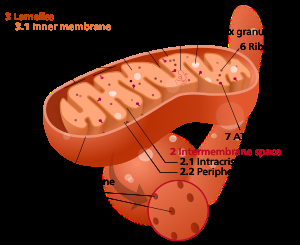For information purposes only. Exercise at your own risk
Please note – studies in the blog post are referenced by the scientist’s name and then the year in brackets. eg. Williams (1994) refers to a scientist called Williams, who carried out a relevant study in 1994. “et al” basically means “and colleagues” i.e. other scientists helped out.
From all areas of sport and exercise, there are many factors that contribute to a successful overall performance. According to Williams (1994):
‘physical performance is mainly a function of an individual’s size, shape, sex, and age’.
Although these factors stated by Williams play a large part in the overall performance of an athlete, success in sport at a performance level depends on more important aspects.

Since pioneering research carried out by Hill et al (1923) in the area of oxygen uptake and its effects on physical performance, much research has followed to examine the limiting factors of performance.
In recent years, there have been a number of researchers challenging the early studies of Hill et al, and more recent research, carried out mainly by Professor Noakes, has caused many people to reconsider the main limitations to physical performance.
This post will examine the current theories and statements regarding the limiting factors of physical performance, focusing mainly on the affecting factors of oxygen uptake and muscle demand that affect physical performance. The second part of the paper will review the current research derived mainly from studies carried out by Bassett et al and Noakes to identify, and challenge, the current theory relating to the limiting factors of physical performance.
Maximum Oxygen Uptake and Muscle Demand:
Background and Current Theory
The importance that the limiting factors of oxygen uptake and muscle demand have on performance was highlighted by Noakes (1987), who reported that :
‘improvements in VO2max that result from physical training or other interventions have been explained on the basis of either enhancing oxygen delivery to the tissues, or of peripheral adaptations including increased muscle capillarisation and an increased mitochondrial oxidative capacity’.
NOAKES (1987)
Maximum oxygen uptake is defined as ‘the highest rate at which oxygen can be taken up and utilised by the body during severe exercise’ Bassett et al (2000). It is more commonly known as VO2max, and is frequently used to indicate the cardiorespiratory fitness of an individual. Due to this, there has been a lot of interest in identifying the physiological factors that limit VO2max ,and also determining the role that it has in endurance performance. Current research is split as to whether VO2max is the determining factor to endurance performance, with Noakes (1987) stating that ‘maximal oxygen uptake does not limit endurance performance’, and Bassett et al (2000) stating that ‘overwhelming research has shown that performance in endurance events is limited by oxygen delivery’.
If we are to determine the role that maximum oxygen uptake and various muscle factors play in endurance performance, we need to understand its limiting factors and the part they play in the process.
On this issue, Bassett et al (2000) stated that
‘the pathway for O2 from the atmosphere to the mitochondria contains a series of steps, each of which could represent a potential impediment to O2 flux’.
Through reading a plethora of papers on the limiting factors to oxygen uptake, there seems to be three variables of the oxygen transport process that are regularly discussed.
1) The Pulmonary Diffusing Capacity
According to Bassett et al (2000), ‘in the average individual exercising at sea level, the lungs perform their job of saturating the arterial blood with O2 extremely well. Even during maximal work, the arterial O2 saturation remains around 95%’. Although untrained athletes work efficiently at sea level, Dempsey et al (1984) stated ‘elite athletes are more likely to undergo arterial O2 desaturation during maximal work compared to untrained individuals’.

This occurs because trained individuals have a much higher maximal cardiac output than untrained individuals, 40 L-min – 1 compared to 25 L-min – 1 (Brooks et al 1996). On this issue, Dempsey et al (1984) stated ‘this leads to a decreased transit time of the red blood cells in the pulmonary capillary. Consequently, there may not be enough time to fully saturate the blood with O2 before it exits the pulmonary capillary’.
According to Powers (1989), ‘this pulmonary limitation can be overcome by O2 enriched air’. Powers (1989) also stated that ‘exercise ability can be increased with supplemental O2 which increases the driving force for O2 diffusion into the blood’.
The ability to increase exercise capacity in this manner shows the presence of a pulmonary limitation on performance.
2) Maximum Cardiac Output
Early research carried out by Hill et al (1923) speculated that maximal cardiac output values of 30 – 40 L-min – 1 were possible in trained athletes. This research was based on knowledge of the Fick equation (see appendix I) and assumed values for VO2max arterial oxygen content, and mixed venous oxygen content.
The affect cardiac output has on the VO2max of an athlete is one that has received many longitudinal studies aimed at identifying it as a imitator to performance. Saltin et al (1968) examined VO2max in sedentary individuals after 20 days of bed rest, and 50 days of training. The difference in VO2max between the deconditioned and trained status resulted mostly from a difference in cardiac output. These findings were echoed by Ekblom et al (1968) who carried out a similar study and found that 16 weeks of physical training increased VO2max from 3.15 to 3.68 L – min –1. This improvement in VO2 resulted from an 8.0% increase in cardiac output, and a 3.6% increase in a – VO2 difference.

To support the theory that a – VO2 difference is not a variable that determines VO2max, reported by Saltin et al (1968) , Cerretelli et al (1987) stated that ‘the oxygen content of arterial blood is approximately 200ml O2 –L-; in venous blood draining from maximally working muscles it falls to 20 – 30 ml O2’. This was also supported by Brooks et al (1996) who stated ‘in most healthy people living at sea-level, the oxygen capacity of blood is approximately 18 – 30ml in maximally working muscles’. These results show that during heavy exercise, there is little amounts of oxygen available to be taken out of the blood.
To conclude his results, Cerretelli et al (1987) stated that ‘the dominant mechanism for the increase in VO2max with training must be an increase in blood flow’. This conclusion was supported by Bassett et al (2000), who stated that ‘it is estimated that 70 – 85% of the limitation in VO2max is linked to maximal cardiac output’.
3) Oxygen Carrying Capacity
Another method of altering the O2 transport to working muscles is by increasing the overall oxygen carrying capacity of the blood. The oxygen carrying capacity of the blood is also a factor that will determine the maximum oxygen uptake of the athlete. This area is one which has received a lot of attention for the wrong reasons as induced erythrocythemia, commonly known as blood doping, has been a common way of enhancing physical performance in recent years. Athletes and sportsman have used this method to gain unfair advantage over opponents, and is a method which is often difficult to detect.
According to Gledhill (1985), blood doping is ‘the practice of artificially increasing a persons volume of total red blood cells through removal, storage, and subsequent reinfusion’. This procedure has been shown to increase VO2max by 4.9% (Gledhill,1985 ).
In blood doping, blood is withdrawn and stored. After the persons blood volume and red blood cells rise to their normal levels, the stored red blood cells are reinfused, thus increasing the blood’s oxygen carrying capacity. Another form of adjusting the levels of red blood cells present in the blood is to take the drug erythropoietin, often known as EPO. By taking EPO, the production of red blood cells are increased, leading to the same benefits found by blood doping. The taking of this drug is also illegal, but easier to detect than blood doping.
To conclude, it seems that there is a number of different techniques and strategies that can be adopted to manipulate the oxygen carrying capacity. Unfortunately, a lot of these techniques are illegal and give athletes unfair advantages over others. The ethical issue’s aside, there is evidence shown above that the manipulation of the oxygen carrying capacity is a major limitator to physical performance, particularly endurance events. This was also the conclusion of Bassett et al (2000), who stated that ‘the evidence that VO2max is limited by the cardiac output, the oxygen carrying capacity, and in some cases the pulmonary system, is undeniable’.
Muscle Factors and Their Limitations Since the challenging of theories of Hill et al (1923) by Noakes (1987), we have become more aware of the possibility of various muscle factors being the major limiting factor to physical performance. Various theories and opinions raised in Noakes’s ‘Contemporary’ views have forced professionals to consider the differing effects that various muscle factors have on the overall performance.
1) Mitochondrial Enzyme Levels
There have been many studies carried out to identify what effect differing levels of Mitochondrial enzymes have in working muscles. Theory has stated that an increased level of mitochondrial enzymes will be able to extract more O2 from the blood and utilise it faster , but does this have an effect on overall VO2max? This theory was researched and subsequently supported by Holloszy et al (1984) who stated that ‘the increase in muscle mitochondria may allow a slightly greater extraction of O2 from the blood by the working muscles, thus contributing in a minor way to an increased VO2max’.

On this issue, Saltin et al (1977) found that ‘there is only a modest increase in VO2max (20 – 40%) despite a 2:2 fold increase in mitochondrial enzymes’. This is consistent with the view that VO2max is limited by oxygen delivery and not muscle mitochondria. This again was supported by Bassett et al (2000) who found that ‘VO2max is constrained by oxygen delivery and not by the mitochondria’s ability to consume oxygen’.
2) Peripheral Diffusion Gradients
In research carried out to analyze limiting factors to VO2max, Honig et al (1992) found that ‘ the principle site of resistance to O2 diffusion occurs between the surface of the red blood cell and the sarcolemma’.
Due to these results, they concluded that ‘O2 delivery is not the limiting factor, and simply increasing blood flow to isolated muscle is not sufficient to cause VO2 to increase’. This view was also shown by Bassett et al (1997), who stated that without a peripheral diffusion gradient, oxygen uptake will not increase’. Of the two main muscle limitators, peripheral diffusion gradients and mitochondrial enzyme levels, it is still unclear as to the extent that these muscle factors inhibit performance compared to oxygen transport. On this issue, Honig et al concluded that ‘VO2max is a distributed property, dependant on the interaction of O2 transport and mitochondrial O2 uptake. However, we cannot determine which of these two factors limits VO2max in the human performing maximal exertion’.
Cellular Metabolism as a Limiting Factor
Noakes (1987) has stated in his various research that ‘oxygen supply does not limit either VO2max or endurance performance’. Rather, the limiting factors are biomechanical. According to Brooks et al (1996), ‘limiting factors include decreases in the rate and force of myofibrillar cross-bridge cycle activity’.
Brooks et al (1996) also stated that
“other limiting factors may be calcium transport mechanisms or decreased myofibrillar ATPase activity”
This evidence shows that there are other physiological factors to discuss, in terms of performance limiters, other than oxygen delivery and muscle factors.
Central or Peripheral Limitations
This remains an area that has received much debate in regards to central factors being the major limiting factor rather than peripheral. Most of the modern day research has been published, and subsequently refuted with regards to improper technique or results. Early research was carried out by Saltin et al (1976), who conducted studies examining the effects on one-legged cycling performance on VO2max.
The results highlighted a 23% increase compared to a 7% increase in the control leg. The authors concluded that ‘the disparity between legs was attributed to peripheral adaptations occurring within the trained skeletal muscle’. And ‘peripheral factors were dominant in limiting VO2max’. These results are similar to the previously stated study by Secher et al (1979), who found that the main limitation was down to peripheral factors. This area has not received as much research as that of the cardiorespiratory system because of the difficulty’s associated with testing central and peripheral factors, and the ease of testing all areas of the cardiorespiratory system.
Critical Review of Limiting factors to Physical Performance
‘Classical Vs Contemporary’
In recent years, the classical theories of Hill et al (1923) have come under scrutiny regarding their factual content and accuracy. The importance of this early research has been highlighted by Bassett et al (1997) who stated that ‘Hill et al were among the first to describe the concept of an upper limit to the body’s ability to consume oxygen’. This challenging of theory that has provided early understanding of the role of maximal oxygen uptake, has caused many researchers to review their current understanding of the limiting factors to physical performance. This contemporary view of limiting factors by Noakes is as follows.
Noakes believed that exercise fatigue was not controlled by the muscles or heart, but by a ‘governer’ in the brain which guards against exhaustion and induces the muscles to cease functioning.
According to Noakes ( 1987) ‘the brain is in total control and regulates the amount of effort you put into exercise’. He concluded that ‘all the evidence shows that the brain will only allow you to use a small amount of muscle bulk – about 20% – after just 30 seconds. If you did keep going, you would produce too much heat, overstress the heart, and it could go into failure’.
Since Noakes (1987) published his contemporary views on limiting factors, many researchers have either agreed with his views, or defended the original theories by Hill and Lupton (1923) that have provided the basic theory behind the majority of their own research. Through analysing the papers released, there seems to be key limiting factors that are being discussed.
This section will analyze the evidence provided by a number of research papers to determine what factors determine physical performance, and to try to answer the key questions regularly asked in current research.
1) Is the VO2 Plateau Proof of a Cardiorespiratory Limitation?
The basis for this question is from the belief that maximal exercise performance is limited by the inability to provide working muscles with oxygen at a rate consistent with demand. This belief the major factor challenged by Noakes (1987) who stated that ‘one of the most fundamental beliefs in exercise physiology is that performance during maximum exercise of short duration is limited by the inability of the heart and lungs to provide oxygen at a rate sufficiently fast to fuel energy production by the active muscle mass’.
This belief has originated from Hill et al (1923), and is one of the key theories that are to be challenged.
One of the most common errors in the issue of the ‘plateau phenomenon’ is the belief that Hill et al (1923) published data claiming to show a plateau during a maximal oxygen consumption experiment. This is untrue, and the authors actually felt that there was no plateau present in the data. According to Noakes (1987), ‘the authors believed that there was no ‘plateau phenomenon’, and that humans reached a highest value of 4 L-min-1. The oxygen intake attains its maximum value, which in athletic individuals of about 75kg is strikingly constant of about 4L-min-1’.
In response to this, Bassett et al (1997) stated that ‘even under carefully controlled laboratory conditions, a variable percentage (30 – 95%) of subjects which exhibit a plateau in VO2 at the end of a graded exercise test’. It seems that each author, Bassett and Noakes, has interpreted the data differently, and come to their own radically different conclusion. It seems that Noakes has reached this conclusion in error. On this issue Bassett et al (1997) stated that ‘Noakes chose to re-fit Hill’s velocity versus VO2 data using a linear equation. We are puzzled by this re-interpretation of A.V Hills data, since it appears to be biased towards the view that a plateau does not exist’.
Post Hill et al, many studies have followed in this area, with many researchers prior to Noakes challenging the theory.
Taylor et al (1955) during their study concluded that they were able to find a plateau in 108 of his subjects. This at the time seemed like proof of its existence, but the results collected were recommended to be ‘treated with circumspection’ according to Wyndhan (1959). A study carried out by Cumming et al (1972) found ‘only 43% showed the equivalent of a plateau phenomenon’.
To conclude their study, the author stated that ‘the plateau is theoretically exact, in practice its much less so’. Similar results were collected by Freedson et al (1986) who found ‘less than 40% of 301 adults undergoing maximal exercise testing showed a plateau in oxygen consumption’.
It seems that many researchers have experienced plateau’s in there subjects during maximal testing, but it seems that it is not a major variable in the issue of what limits maximal performance. If studies have recorded less than 50% of their subjects experienced a plateau in oxygen utilisation, there must be other variables that are limiting the performance.
This view is also shown by Bassett et al (1997) who stated that
‘VO2max sets the upper limit for energy production endurance events, but does not determine the final performance’.
Bassett 1997
This applies to physical performance conducted at sea-level, and there will be differing limitating factors in regards to performance at differing altitudes or climates. At higher altitudes, the decreased PO2 gradient between the alveolus and the pulmonary capillary can result in a pulmonary diffusion limitation (Bassett, 1997).
2) Is the Cardiorespiratory System the Major Limitation?
It seems that popular belief is that the cardiorespiratory system is the major limiting factor of physical performance. According to Wagner et al (1991), ‘ VO2max must be determined by the capability to deliver O2 to muscle mitochondria via the transport system, rather than by the properties of the muscles contractile machinery’.
As already stated, the cardiac output of an athlete is a limiting factor as an increased cardiac output may not allow full saturation of the blood with O2.On this issue, Hill et al (1923) proposed that ‘maximal cardiac output was the primary factor explaining individual differences in VO2max’. This view was supported by research carried out by Lindhard (1984) who measured cardiac outputs of 20 L-min-1 in average subjects during exercise, and demonstrated the strong linear relationship between cardiac output and VO2’. Although a high cardiac output is a limiting factor, other than O2 enriched air, beta blockers are used to control it.
Research in this area carried out by Tesch (1985) stated that ‘beta blockers can decrease maximal heart rate by 25 – 30%, reducing cardiac output by 15 – 20%’. This de-limitation is a successful way of improving the capacity to saturate the blood with oxygen, but is impractical as it is illegal in professional sport.
Research carried out by Secher et al (1979) showed the limitations that the cardiorespiratory system has on performance. They had seven subjects cycle for 20 minutes, and for the first 10 minutes the subjects pedalled at approximately 68% of their leg VO2max. They then added arm-cranking while continuing to maintain the same leg power output with the legs. The results showed that the cardiac output was unable to supply the demands of the combined muscle mass, and still maintain blood pressure.
The results were not supported by Bergh et al (1999) who stated that ‘adding maximal arm exercise to maximal leg exercise does not increase peak oxygen uptake more than expected’.
This limitation of the cardiorespiratory system in contrast to the following evidence supporting the skeletal system to work efficiently during intense exercise has shown the main limitations that are present.
According to Bassett et al (2000), ‘if isolated knee extensions are performed with one leg, the amount of active muscle mass is only 2 – 3kg. Under these conditions, the blood flow reaches 240mL per 100g tissue, and oxygen uptake can attain values 300 – 400 mL ; kg –1 min’.
Bassett et al (2000), who reviewed the two studies, stated that ‘they demonstrate that the central cardiorespiratory system is the primary determinant of VO2max in the average individual performing large muscle group activities’.
This conclusion was also found by Rowell et al (1986) who stated that ‘today, most physiologists believe that the capacity of the cardiorespiratory system to transport oxygen to the tissues is the principle determinant of VO2max’.
Conclusion
I feel that through reading the plethora of research on the subject of what limits human performance, there does not seem to be a common theory adopted. There always seems to be, as Bassett stated of Noakes, ‘iconoclast’s’ who will seek to disrepute evidence as soon as it’s published.
If I am to establish my own opinion on the issue, I will need to disregard a lot of the evidence that has been published by both Noakes and Bassett et al, as they seemed to lose the perspective of what they were aiming for. The continuing ‘rebuttals’ published by both authors seemed more about disproving the other, and less about actually proving what the key limitations are.
I feel that the evidence that I have collected and presented has led me to believe that the main imitator to exercise performance is that of the cardiorespiratory system. Many studies have concluded with cardiac output and pulmonary diffusion being linked, and together being the main imitator. This is turn leads to another limitation of performance, in the form of mitochondrial enzyme levels.
There is not one primary factor that alone limits performance, but there are many that affect in differing amounts. A comparison would be that of a ‘spider’s web’ effect were many factors together creating the overall product, and weakness in one area can affect the overall structure.
I have shown evidence that states a higher level of mitochondrial enzymes present does not necessarily lead to increased efficiency of removing O2 from the blood, and preventing the build up of lactic acid. This was shown to be the case in studies that I have previously included, and shows that this cannot be included as a main limiting factor because of its dependency on other variables.
I must state though that I believe Noakes should be credited in challenging the original theories of Hill et al and challenging fundamental principles, but I think that often he has manipulated findings and statements to fit his own contemporary views.
This view was shared by Bergh et al (1999), who stated that ‘Noakes’s line of reasoning has not honoured the basic fundamental principles very well’. Bergh et al also stated that ‘his (Noakes) two papers demonstrate the consequences of violating those fundamental principles’. Therefore, neither his evaluation of classical versus contemporary viewpoints nor his rejection of what he calls the ‘cardiovascular/anaerobic’ models becomes convincing.

